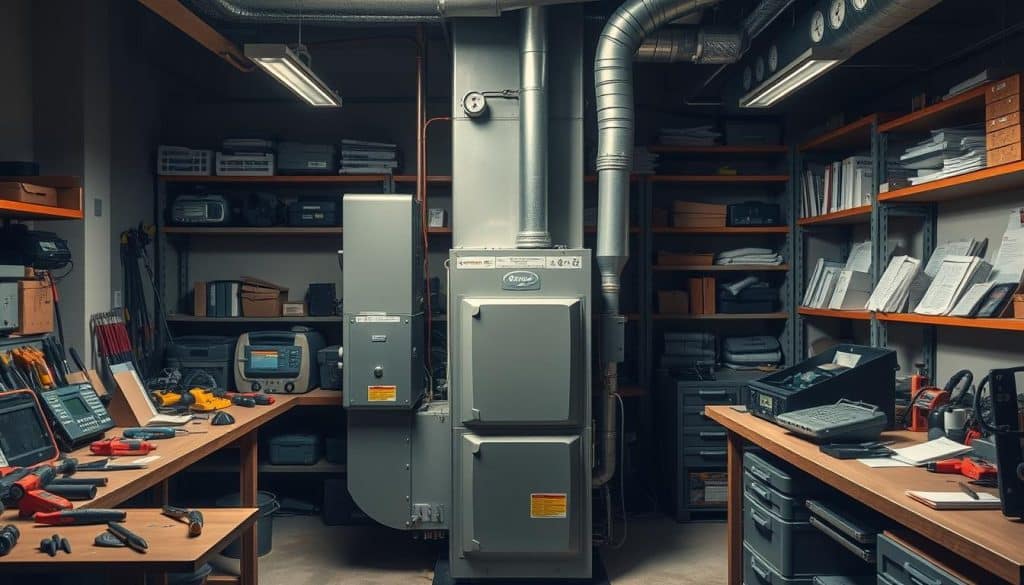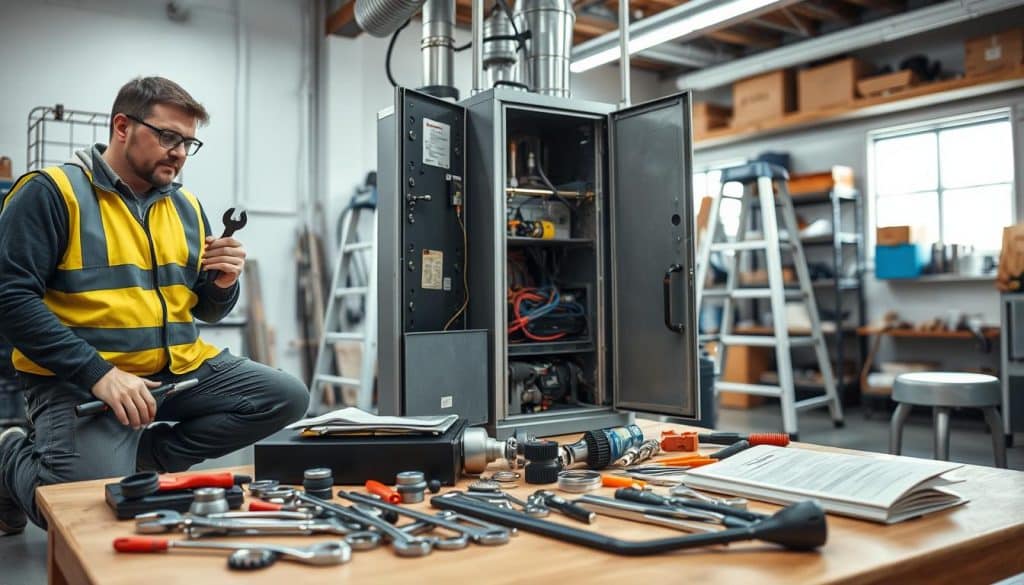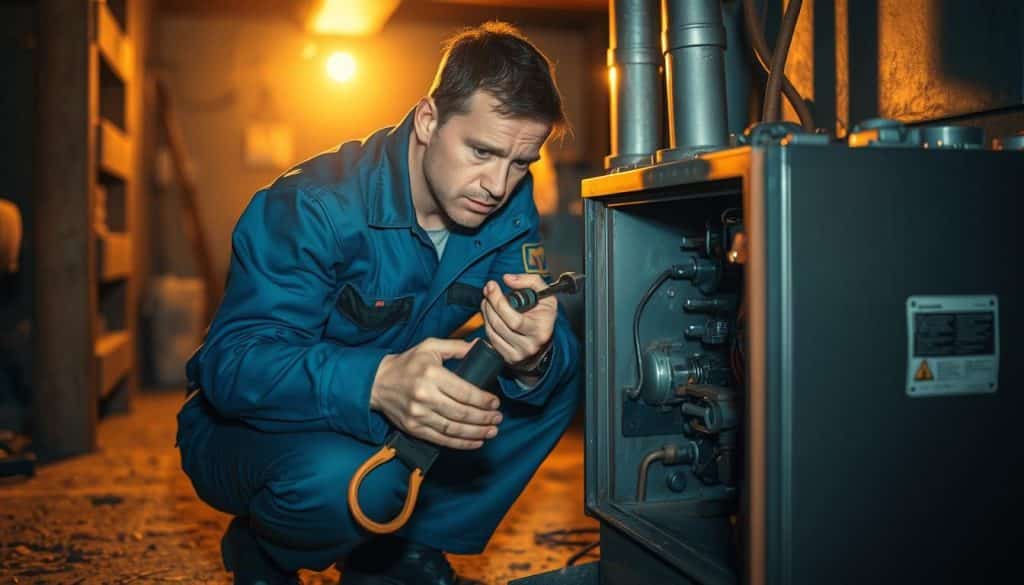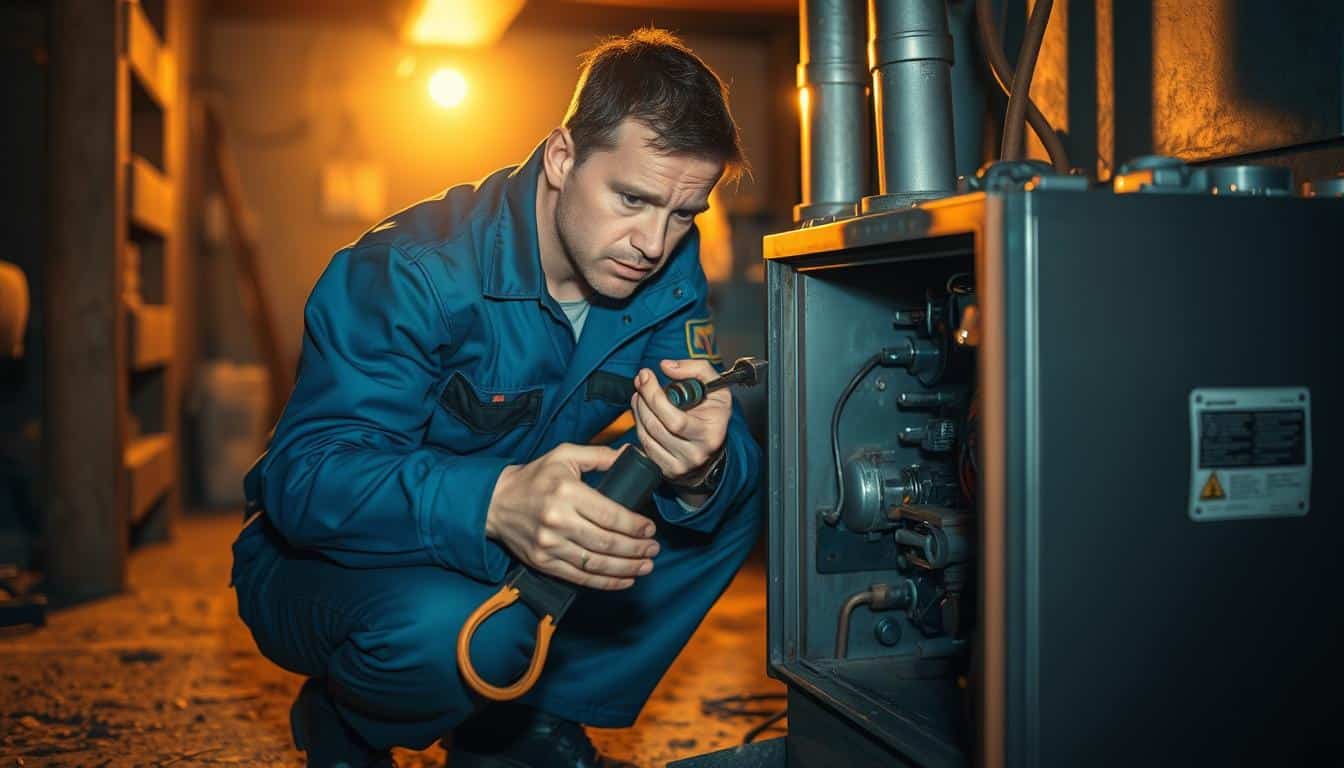Table of Contents
Ever thought What Should I Do if My Furnace Stops Working? Imagine waking up on a frigid Canadian winter morning to find your home icy cold. A malfunctioning furnace can quickly turn your comfortable space into an uncomfortable environment. This situation is critical during harsh Canadian winters, where heating is a necessity, not a luxury. The question on everyone’s mind is, what should I do if my furnace stops working?
The first step is to remain calm and assess the situation. Listen for unusual noises, check the thermostat settings, and ensure the airflow is functioning properly. A well-maintained furnace is key for comfort and energy efficiency. If the issue persists, professional help may be needed.
Raye-Van Enterprises Inc., with over 31 years of experience in HVAC services, is here to help. They offer 24/7 emergency service, specializing in furnace repairs, air duct cleaning, and more. Their team of licensed gas fitters ensures quality and safety are never compromised.
In the following sections, we will guide you through diagnosing and addressing furnace issues. From initial checks to understanding when professional help is needed, we’ve got you covered.
Key Takeaways
- Assess the situation calmly and perform initial checks like thermostat settings and airflow.
- A well-maintained furnace is essential for comfort and energy efficiency.
- Raye-Van Enterprises Inc. offers professional HVAC solutions, including 24/7 emergency service.
- Quality and safety are key when addressing furnace issues.
- Upcoming sections will provide a detailed guide to diagnosing and fixing furnace problems.
Understanding Your Furnace’s Operation
Knowing how your furnace works is key to identifying issues early. A typical gas furnace operates by igniting natural gas to produce heat, which is then circulated through your home via a blower motor. This process ensures consistent warmth, essential during Canada’s cold winters.
How Furnaces Provide Heat
The furnace’s heating cycle begins when the thermostat detects a drop in room temperature. It signals the furnace to ignite the gas, creating heat. This warmth is distributed by the blower motor through your home’s ducts. Regular checks of the thermostat and airflow at vents are essential for maintaining efficiency.
Recognising Normal Operation Sounds and Airflow
A normally functioning furnace produces sounds like the hum of the blower fan and a gentle whoosh when the burners ignite. Air should flow steadily through vents without unusual noises or weak airflow. These signs help distinguish normal operation from possible issues.
Understanding these basics helps homeowners recognize early warning signs of furnace malfunctions. This ensures timely interventions to maintain comfort and safety.
Initial Diagnostic Steps for Your Heating System
When your furnace stops working, start with some basic checks to identify the issue. These initial steps can help you determine whether the problem is minor or if professional assistance is needed.
Verifying Thermostat and Temperature Settings
Start by checking your thermostat. Ensure it’s set to “heat” and that the temperature is higher than the current room temperature. For battery-operated thermostats, verify that the batteries are not dead. About 50% of furnace issues are due to improperly set thermostats. If your thermostat is functioning correctly, proceed to the next step.
Listening for and Feeling the Airflow
Next, check the airflow from your vents. If you feel weak or no airflow, it could indicate a problem with your furnace’s blower or a clogged air filter. A clogged filter can increase energy consumption by up to 15%. Inspect and clean or replace the filter if necessary to ensure proper airflow.

First, check the thermostat and airflow. Then, look at the circuit breaker panel. A tripped circuit breaker can stop your furnace from working. If you find any problems, write them down to share with a technician.
Regular maintenance can make your HVAC system up to 30% more efficient. For tips on keeping your furnace in good shape, check out our guide on scheduling furnace maintenance.
What should I do if my furnace stops working?
If your furnace stops working, there are simple steps to try. These tips can help you fix minor problems before calling a professional.
Simple Troubleshooting Guidelines
First, check the pilot light. Make sure it’s lit. If it’s not, follow your furnace’s manual to light it. Next, check the switch that turns on your furnace. It might have been turned off by mistake.
Look for a tripped circuit breaker or a blown fuse. Check your home’s electrical panel. If the breaker for your furnace has tripped, reset it. If it trips again, you might need a professional.
If these steps don’t work, try a basic reset procedure. Some furnaces have a reset button. If your furnace doesn’t work after these steps, call a licensed technician.
It’s important to document what you’ve tried. This helps technicians find the problem quickly when they arrive for a repair. Fixing furnace issues fast keeps your home warm and safe.
Practical Troubleshooting and Reset Procedures
When your furnace malfunctions, tackle the problem step by step. This section guides you through common furnace issues.
Inspecting the Pilot Light and Gas Supply
Start by examining the pilot light. Ensure it’s lit and burning steadily. A faulty pilot light can prevent your furnace from igniting. If it’s out, refer to your furnace’s manual for safe relighting instructions. Next, check the gas supply to confirm it’s uninterrupted. A closed valve or interrupted service could be the root cause of the issue.

Always turn off the power before performing any inspections to ensure your safety.
Resetting Your Furnace and Circuit Breakers
If your furnace stops working after a power outage, try resetting it. Look for your home’s electrical panel. Check if the circuit breaker for your furnace has tripped. Reset it and see if your furnace works again.
If it trips again, you might have a bigger electrical problem. This could need a professional to fix.
Some furnaces have a reset button. Press and hold it for a few seconds, then release. If your furnace doesn’t work after these steps, call a licensed technician.
Advanced Diagnostic Checks and Maintenance Tips
Keeping your furnace running well needs more than just basic checks. Advanced diagnostics and regular maintenance can make it last longer and work better. This section will guide you through detailed steps to find and fix deeper problems.
Assessing Electrical Components and Gas Controls
First, check the electrical panel and gas controls. A bad panel or gas valve can stop ignition. Look at the burner for wear and make sure all connections are tight. A tight setup stops gas leaks and ensures ignition works right.
Cleaning or Replacing Air Filters and Flame Sensors
A dirty air filter can cut down airflow and efficiency. Change it every 1-3 months. Also, clean the flame sensor often to avoid ignition problems. A clean sensor helps the burner light up right, keeping you safe.
Regular maintenance boosts efficiency and extends your furnace’s life. Fixing these areas keeps your heating system running smoothly and safely.
Emergency Furnace Repair and Safety Measures
When your furnace breaks down in the cold Canadian winter, you need to act fast. This section will guide you on what to do and how to stay safe when your furnace stops working in freezing weather.
Steps to Take When Immediate Help Is Needed
If your furnace stops working in the cold, first check the circuit breaker or fuse box. A tripped breaker or blown fuse can often be reset. Then, check the switch that powers your furnace to make sure it’s on. If these steps don’t work, call a qualified technician for emergency repair.
Maintaining Safety During Cold Weather
When your furnace isn’t working, safety is key. Make sure all vents are clear to keep airflow right. Never try to fix it yourself, as it can be dangerous. If you’re waiting for a technician, use electric space heaters but always follow safety rules to avoid fires.

Remember, emergency repairs should only be handled by professionals to protect your home and family. Stay safe and warm until help arrives.
Raye-Van Enterprises Inc. – Your Local HVAC Experts
For over 31 years, Raye-Van Enterprises Inc. has been a trusted name in HVAC services across Canada. They specialize in furnace repair, air duct cleaning, and boiler servicing. They provide solutions to keep your home comfortable and safe.
Over 31 Years of Professional HVAC Services
Raye-Van Enterprises is locally owned and operated. They understand Canada’s climate challenges. Their team of licensed gas fitters offers top-notch service, whether it’s an emergency repair or routine maintenance.
Contact Information: (604) 530-0063 | info@furnacerepairing.ca
Raye-Van Enterprises is committed to quality and safety. They offer 24/7 emergency service for urgent issues. They stay updated on the latest HVAC technologies through continuous education.
For reliable HVAC services, contact Raye-Van Enterprises at (604) 530-0063 or email info@furnacerepairing.ca. They prioritize your comfort and safety, providing expert solutions tailored to your needs. Visit their guide on boiler replacement for more information.
Conclusion
Regular furnace maintenance and early issue detection are key for a warm and safe home. Always check your thermostat settings and ensure proper airflow to avoid common problems. A well-maintained heating system reduces costly repairs and prevents unexpected breakdowns.
Take proactive steps by addressing minor issues early and knowing when to seek professional help. If troubleshooting steps don’t resolve the problem, contact experts like Raye-Van Enterprises for assistance.
A well-maintained furnace not only saves money but also ensures your home remains comfortable during harsh winters. Trust local experts to handle complex repairs and maintenance, giving you peace of mind.
By following these steps, you’ll effectively manage furnace issues and keep your home warm and safe all year round.
Raye-Van Enterprises Inc. is here to help with any furnace-related needs, ensuring your comfort and safety.
FAQ
What are the first steps if my furnace stops working?
Start by checking the thermostat settings to ensure it’s set to heat mode. Next, inspect the circuit breaker to confirm it hasn’t tripped. If it has, reset it and observe if the furnace resumes operation.
How do I check the air filter?
Find the air filter, usually near the furnace or in the return air duct. Remove it and check for dirt. If it’s dirty, replace it with a new filter to restore proper airflow and efficiency.
What if the pilot light is out?
First, make sure the gas supply is on. If the pilot light is out, follow the manufacturer’s instructions to relight it. If you’re unsure or uncomfortable, contact a certified HVAC technician for assistance.
Why is checking the venting system important?
Clear the venting system of any blockages to ensure proper function. A blocked vent can cause the furnace to shut down, so check both intake and exhaust vents for debris or obstructions.
When should I call an HVAC expert?
If initial troubleshooting doesn’t resolve the issue, contact a professional. They can diagnose complex problems and ensure repairs are done safely and correctly, even with gas systems.
What are emergency steps during winter?
If the furnace fails and you can’t get it fixed immediately, use space heaters safely or consider temporary relocation. Always prioritize your safety and comfort during cold weather.



